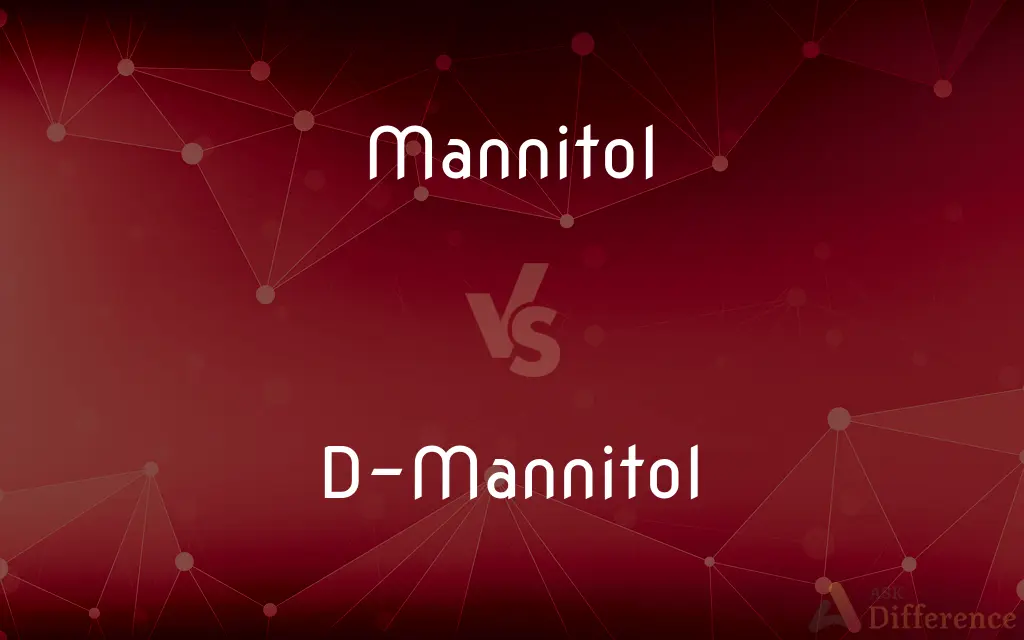Mannitol vs. D-Mannitol — What's the Difference?
By Tayyaba Rehman — Published on November 11, 2023
Mannitol is a type of sugar alcohol used medically and in food, while D-Mannitol refers specifically to the naturally occurring optical isomer of mannitol.

Difference Between Mannitol and D-Mannitol
Table of Contents
ADVERTISEMENT
Key Differences
Mannitol is a generic term that refers to a sugar alcohol that has a variety of applications, particularly in the medical field and food industry. D-Mannitol, on the other hand, zeroes in on the specific stereochemistry of mannitol, pointing to its natural and most common form.
Both Mannitol and D-Mannitol possess diuretic properties, which means they promote urine production. This has made mannitol particularly useful in medicine, especially when reducing intracranial pressure or treating certain kidney diseases. D-Mannitol, being the naturally occurring form, is what's commonly used in these medical applications.
When it comes to food production, Mannitol serves as a sweetener and can be used in products where moisture retention is crucial. It's also beneficial for individuals who need to manage their blood sugar, as mannitol has a much lower glycemic index than typical sugars. In this context, D-Mannitol specifically denotes the form of mannitol being utilized, ensuring it's the natural variant.
Chemically, all carbohydrates, including Mannitol, can exist in various forms called stereoisomers, which are molecules with the same molecular formula but a different arrangement of atoms. D-Mannitol is a specific stereoisomer of mannitol. While there are other potential isomers, D-Mannitol is the one that's naturally prevalent and commercially important.
The "D" in D-Mannitol refers to the configuration of the molecule and its optical activity. Without the "D" designation, Mannitol could technically refer to any stereoisomer of the compound, but in most practical contexts, Mannitol and D-Mannitol are used interchangeably since the naturally occurring form is the predominant one.
ADVERTISEMENT
Comparison Chart
Definition
A sugar alcohol with multiple uses.
The naturally occurring optical isomer of mannitol.
Optical Activity
Can theoretically refer to any form of mannitol.
Specifically refers to the dextrorotatory form.
Occurrence
Refers broadly to the compound's class.
Refers to the specific form found in nature.
Commercial Importance
Used generally to denote the compound in industries.
Specifies the exact variant used in products.
Structural Specification
Doesn't indicate the spatial arrangement of atoms.
Denotes a specific stereochemical configuration.
Compare with Definitions
Mannitol
A compound used to retain moisture in foods.
Mannitol's inclusion in the recipe ensures the cake remains moist.
D-Mannitol
The primary stereoisomer used in commercial products.
D-Mannitol's properties make it suitable for a range of products, from medicine to food.
Mannitol
A carbohydrate that can exist in various stereoisomers.
Mannitol's specific structure determines its properties and uses.
D-Mannitol
The naturally occurring form of mannitol.
D-Mannitol is predominantly found in nature and used in medical applications.
Mannitol
A sugar alcohol used as a sweetener.
Mannitol is a popular choice for diabetic-friendly candies.
D-Mannitol
A dextrorotatory sugar alcohol.
The D in D-Mannitol indicates its optical activity.
Mannitol
A substance with a lower glycemic index than regular sugar.
For blood sugar management, mannitol can be an alternative sweetener.
D-Mannitol
A specific configuration of mannitol.
D-Mannitol has a unique spatial arrangement of its atoms.
Mannitol
A diuretic in medical applications.
The patient was given mannitol to reduce intracranial pressure.
D-Mannitol
The mannitol variant with established safety in food and medicine.
Due to its natural occurrence, D-Mannitol is widely accepted and used.
Mannitol
A white, crystalline, water-soluble, slightly sweet alcohol, C6H8(OH)6, found in plants, algae, and fungi. It is used in medicine, especially for its diuretic properties, and in foods as a sweetener and texturizer.
Mannitol
(organic compound) A polyhydroxy alcohol, an isomer of sorbitol, used as an artificial sweetener.
Mannitol
A white crystalline hexose (HO.CH2.(CHOH)4.CH2.OH) of a sweet taste obtained from a so-called manna, the dried sap of the flowering ash (Fraxinus ornus); - called also mannite, and hydroxy hexane. Cf. Dulcite. It is used in pharmacy as excipient and diluent for solids and liquids. It is also used as a food additive for anti-caking properties, or as a sweetener, and, illegally, to "cut" (dilute) illegal drugs such as cocaine or heroin.
Mannitol
A diuretic (trade name Osmitrol) used to promote the excretion of urine
Common Curiosities
Why is mannitol used in medical procedures?
Mannitol can help reduce intracranial pressure and is also used as a diuretic in certain kidney conditions.
Can mannitol be used by diabetics?
Yes, mannitol has a low glycemic index, making it suitable for diabetics as a sweetener.
Can mannitol be used in baked goods?
Yes, mannitol is sometimes used in baked goods as a sweetener and for its moisture-retaining properties.
How does D-Mannitol differ from L-Mannitol?
D-Mannitol and L-Mannitol are mirror-image isomers; D-Mannitol is naturally occurring, while L-Mannitol is its unnatural counterpart.
Are there side effects associated with mannitol consumption?
Yes, excessive consumption can cause digestive issues, and when used medically, it might have other side effects that should be discussed with a healthcare professional.
In which industries is D-Mannitol predominantly used?
D-Mannitol is widely used in the pharmaceutical, medical, and food industries.
What's the difference between mannitol and other sugar alcohols like xylitol?
While both are sugar alcohols, they have different chemical structures, sources, and potential applications.
Is D-Mannitol naturally occurring?
Yes, D-Mannitol is the form of mannitol that naturally occurs in plants and fungi.
Can D-Mannitol be synthesized in the lab?
Yes, while D-Mannitol is naturally occurring, it can also be synthesized for commercial purposes.
Is mannitol safe for everyday consumption?
In moderate amounts, mannitol is generally considered safe, but excessive consumption can cause digestive issues.
Why is mannitol used in chewing gum?
Mannitol is used in chewing gum because it provides sweetness without promoting tooth decay.
Does mannitol have calories?
Yes, mannitol has about 1.6 calories per gram, which is less than regular sugar.
Share Your Discovery

Previous Comparison
Optical Rotation vs. Specific Rotation
Next Comparison
Ex-Showroom Price vs. On-Road PriceAuthor Spotlight
Written by
Tayyaba RehmanTayyaba Rehman is a distinguished writer, currently serving as a primary contributor to askdifference.com. As a researcher in semantics and etymology, Tayyaba's passion for the complexity of languages and their distinctions has found a perfect home on the platform. Tayyaba delves into the intricacies of language, distinguishing between commonly confused words and phrases, thereby providing clarity for readers worldwide.












































